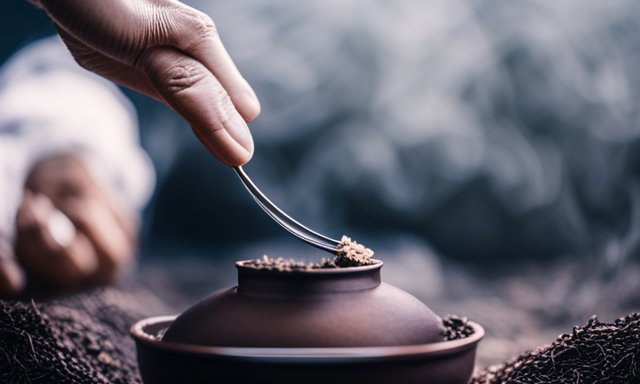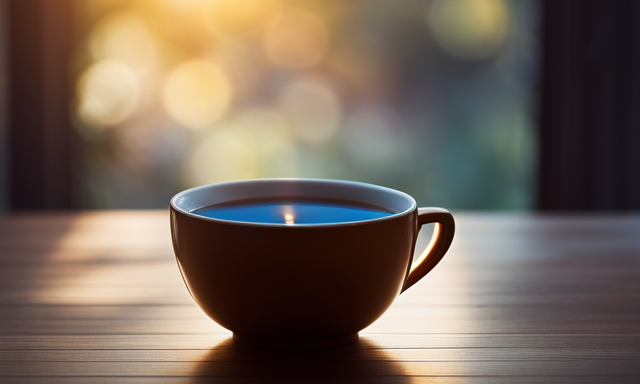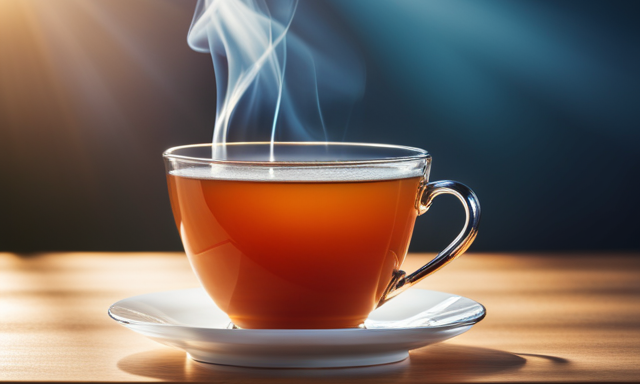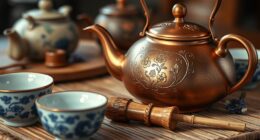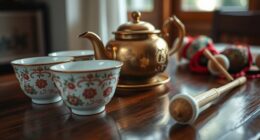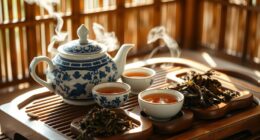Imagine sipping on a warm cup of oolong tea, as its rich aroma engulfs your senses, and its smooth, complex flavors dance on your taste buds. Let me take you on a journey to explore the depths of this fascinating beverage.
Oolong tea, a traditional Chinese tea, is a true marvel of nature. It is crafted with meticulous care, bringing together the best of both green and black teas. This unique combination creates a tea that is partially oxidized, resulting in a distinct flavor profile that is neither too mild nor too strong.
But what exactly is in oolong tea that gives it such a captivating taste? In this article, we will delve into the key ingredients that make oolong tea a beverage beloved by tea enthusiasts around the world.
So, grab your favorite mug and join me as we unravel the secrets of oolong tea.
Key Takeaways
- Oolong tea is rich in antioxidants and supports overall health and well-being.
- It helps boost metabolism, aids in weight loss, and can be a healthy alternative to sugary beverages.
- Oolong tea promotes heart health by reducing the risk of heart disease, lowering cholesterol levels, and enhancing blood circulation.
- It aids in digestion, relieves bloating and indigestion, and supports a healthy gut.
Brief History of Oolong Tea
Oolong tea has a brief but fascinating history that spans centuries. It is believed to have originated in the Fujian province of China in the early 18th century. The unique climate and soil conditions in this region contribute to the exceptional quality of oolong tea. The leaves are carefully handpicked and then partially oxidized, which gives oolong tea its distinct flavor profile that falls between green and black tea. The production process involves withering, rolling, and roasting the leaves to achieve the desired flavors and aromas. Now, let’s delve into the different types and varieties of oolong tea.
Types and Varieties of Oolong Tea
Contrary to popular belief, the world of Oolong tea is a vast and diverse realm, with an array of types and varieties that are sure to bewilder even the most seasoned tea connoisseur.
Oolong tea comes in a wide range of flavors, each offering a unique taste experience. From the floral and aromatic Tie Guan Yin to the rich and nutty Da Hong Pao, there is something to suit every palate. The flavors are influenced by factors such as the tea plant cultivar, growing region, and the specific processing techniques employed.
Speaking of processing, the production process of Oolong tea is meticulous and involves withering, rolling, oxidation, and firing. Each step plays a crucial role in achieving the desired flavor profile.
Now, let’s delve into the fascinating world of the oxidation process of Oolong tea.
Oxidation Process of Oolong Tea
First, let’s take you on a journey into the captivating realm of the oxidation process in the world of Oolong tea.
- The oxidation process is a crucial step in the production of Oolong tea, where the tea leaves are intentionally bruised to encourage enzymatic reactions.
- This process allows the tea leaves to undergo partial oxidation, ranging from 10-70%, giving Oolong tea its unique flavor profile.
- The level of oxidation determines the characteristics of the tea, ranging from light and floral to dark and robust.
- The benefits of Oolong tea’s oxidation process include enhancing the tea’s aroma, flavor, and overall complexity.
- Oolong tea’s partially oxidized leaves also contain polyphenols and catechins, which have been linked to various health benefits.
With an understanding of the oxidation process, let’s delve into the next section about the key ingredients in Oolong tea.
Key Ingredients in Oolong Tea
As you sip on this delightful brew, prepare to be tantalized by the secret blend of ingredients that dance on your taste buds. Oolong tea is a rich source of antioxidants, vitamins, and minerals that offer numerous health benefits. It is produced through a meticulous process that involves withering, oxidation, and rolling of the tea leaves. The key ingredients in oolong tea include catechins, theanine, caffeine, and polyphenols. These compounds contribute to its unique flavor profile and provide various health benefits such as boosting metabolism, promoting heart health, and aiding in weight management. The following table illustrates the key ingredients in oolong tea and their corresponding benefits:
| Ingredient | Benefits |
|---|---|
| Catechins | Antioxidant properties, aids in weight loss |
| Theanine | Promotes relaxation and mental alertness |
| Caffeine | Increases energy levels and focus |
| Polyphenols | Supports heart health and reduces inflammation |
With this understanding of the key ingredients in oolong tea and their benefits, let’s dive into the next section to explore the flavor profile of this exquisite beverage.
Flavor Profile of Oolong Tea
Indulge your palate in the intricate symphony of flavors that Oolong tea offers, as it unveils its delicate notes and subtle nuances.
Oolong tea is known for its complex flavor profiles, ranging from floral and fruity to toasty and nutty. The specific taste of Oolong tea can vary depending on the region it is grown and the brewing techniques used.
The flavors can be influenced by factors such as oxidation level, leaf size, and the duration of the steeping process. The brewing techniques play a crucial role in extracting the optimal flavors from the tea leaves. By adjusting the water temperature, steeping time, and tea-to-water ratio, you can enhance the taste and aroma of Oolong tea.
As we delve into the health benefits of Oolong tea, we will discover how these flavors contribute to its overall goodness.
Health Benefits of Oolong Tea
Let’s explore the numerous health perks that come with savoring this delightful brew.
Oolong tea is not only a delicious beverage, but it also offers a range of health benefits. Packed with antioxidants, it can help boost your immune system and protect against harmful free radicals.
It has been shown to aid in weight management by boosting metabolism and reducing fat absorption. Oolong tea is also known to improve heart health by lowering cholesterol levels and reducing the risk of heart disease.
Additionally, it can help regulate blood sugar levels and promote healthy digestion.
To fully enjoy the health benefits of oolong tea, it is important to brew it properly. Now, let’s dive into the art of brewing and serving oolong tea.
Brewing and Serving Oolong Tea
To properly brew and serve this exquisite beverage, you must pay attention to the temperature of the water and the steeping time, ensuring that you extract the full flavor and aroma of this delicate infusion.
Brewing techniques for oolong tea vary depending on the type of tea leaves, but generally, water heated to about 190°F (88°C) works well. Allow the tea leaves to steep for 3-5 minutes, or follow the specific instructions provided on the packaging. For a stronger brew, you can increase the steeping time, but be careful not to overdo it as it may result in a bitter taste.
Once brewed, oolong tea can be served hot or chilled, depending on personal preference. It pairs beautifully with a wide range of foods, including seafood, poultry, and lightly sweet desserts, complementing their flavors with its subtle floral and fruity notes.
Now, let’s explore the art of pairing oolong tea with food.
Pairing Oolong Tea with Food
After learning about brewing and serving oolong tea, let’s now explore the delightful world of pairing this tea with food.
Oolong tea’s complex flavor profile makes it a perfect companion for a variety of desserts. The rich, floral notes of oolong tea complement desserts like almond cookies, fruit tarts, and even chocolate truffles. Not only does this combination create a harmonious taste experience, but oolong tea can also offer some surprising health benefits when paired with sweets.
Oolong tea has been known to aid in weight loss by boosting metabolism and reducing fat absorption. So, indulging in a slice of cake alongside a cup of oolong tea can be a guilt-free pleasure.
Now that we’ve explored the art of pairing oolong tea with desserts, let’s delve into the next exciting topic – where to buy oolong tea.
Where to Buy Oolong Tea
You can find a wide selection of Oolong tea at specialty tea shops and online retailers. When looking for the best Oolong tea brands, it’s important to consider the quality and origin of the tea leaves. Some popular brands include Tie Guan Yin, Da Hong Pao, and Alishan Oolong. These teas are known for their unique flavors and aromas.
Drinking Oolong tea has several benefits, including boosting metabolism, aiding in weight loss, and promoting heart health. Additionally, Oolong tea is rich in antioxidants and can help improve digestion.
To fully enjoy Oolong tea, it’s best to steep the leaves at the recommended temperature and time, and savor the complex flavors and aromas. So, let’s move on to some tips for enjoying Oolong tea.
Tips for Enjoying Oolong Tea
Now that you know where to buy oolong tea, let’s dive into some tips for enjoying this exquisite beverage.
As an avid oolong tea enthusiast, I have discovered a few secrets to brewing the perfect cup.
First, make sure to use filtered water at a temperature around 195°F (90°C) to bring out the tea’s complex flavors. Steep the tea leaves for about 3-5 minutes, depending on your preference for strength.
Don’t forget to savor the aroma as the tea infuses.
The best time to enjoy oolong tea is in the morning or afternoon when you need a gentle pick-me-up or a moment of relaxation.
Whether you pair it with a light snack or enjoy it on its own, oolong tea is sure to provide a delightful experience for your taste buds and senses.
Frequently Asked Questions
How many calories are in a cup of oolong tea?
Drinking a cup of oolong tea can be a great addition to your weight loss journey, as it contains minimal calories. Additionally, the moderate caffeine content helps boost metabolism, aiding in shedding those extra pounds.
Can oolong tea help with weight loss?
Yes, oolong tea can help with weight loss. It boosts metabolism, helping you burn more calories. It also suppresses appetite, making you feel fuller for longer. Incorporating oolong tea into your routine can support your weight loss goals.
What is the caffeine content in oolong tea compared to other types of tea?
Compared to other teas, oolong tea has a moderate caffeine content. While it can provide a gentle energy boost, it also offers numerous health benefits, such as improving mental alertness and aiding in weight management.
Are there any potential side effects or risks associated with drinking oolong tea?
There are potential side effects and risks associated with drinking oolong tea. It is important to be aware of these, despite the potential health benefits. It is recommended to consume oolong tea in moderation and within the recommended daily intake.
Can oolong tea be cold-brewed or is it best served hot?
Cold-brewing oolong tea is a popular method that enhances its natural flavors. It can be enjoyed both hot and cold. The cold brewing process retains the tea’s health benefits, including boosting metabolism and aiding weight loss.
Conclusion
When it comes to what is in oolong tea, there are several key ingredients that contribute to its unique characteristics and health benefits. One of the main components of oolong tea is polyphenols. These are antioxidants that help protect the body against free radicals and oxidative stress. Polyphenols are known for their potential to reduce inflammation, support heart health, and even aid in weight management.
Another important ingredient found in oolong tea is theanine. This amino acid is known for its calming and relaxing effects. Theanine can help promote focus and concentration, while also reducing stress and anxiety. It is often credited with providing a sense of mental clarity and alertness without the jitters commonly associated with caffeine.
In addition to polyphenols and theanine, oolong tea also contains caffeine. However, the caffeine content in oolong tea is generally lower than that of black tea or coffee. This makes oolong tea a great option for those looking for a moderate caffeine boost without the potential side effects of excessive caffeine consumption.
With its unique combination of polyphenols, theanine, and a moderate amount of caffeine, oolong tea offers a refreshing and invigorating experience. Whether you’re looking for a moment of relaxation or a pick-me-up, oolong tea has something to offer. So why not sit back, savor the flavors, and enjoy the many benefits of this remarkable beverage?



